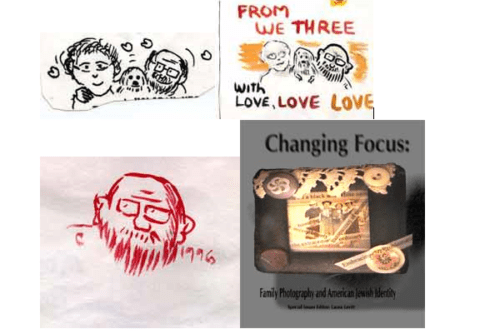For several years after the swimsuit covers are recognizable; they wear bikinis, have unnaturally bronzed bodies, and often embrace themselves uncomfortably. This is only interrupted by the first model of color, Tyra Banks in 1996 (Vol. 84 Issue 4). It is not a coincidence that the appearance of a woman of color on the cover should have (briefly) interrupted this trend. An anxiety about race and sexuality was portrayed most vividly by the fact that in 1996 Banks did not appear alone, but with a white woman, model Valeria Mazza. The text on the cover, which was published just two years after the end of apartheid, reads “South African Adventure,” and at first glance purports to be a depiction of togetherness and diversity – the Black woman and the white woman, wearing leopard print bikinis, lean on each other at the beach. The subtext is drastically different in this falsely ethnographic photograph. The Black woman, here read as African simply because she is non-white, represents the sexual availability and wildness of the female African body. While SI was apparently trying to allay fears about the representation of Black women’s sexuality, what the magazine got instead was a controversy about the racism of its timidity, and the next year Banks appeared alone on the cover, which reads “Nothing But Bikinis,” as if her skin, her race has been erased. It is notable that in the ten years since that time no other Black woman has appeared on the cover of the swimsuit issue, and the 2002 cover, one of the few on which a woman who could be read as non-white appears, Yamila Diaz-Rahi, a Lebanese and Spanish model, states, “Red Hot in Latin America,” again a misreading of all non-white women as being equally capable of fitting into the ethnicity of any non-white country.
More recently we have seen the actual undressing of the model. In 2003 she unties the bottom of her bikini. In 2004 she unties the top. In 2005 the cover aptly states, “The SI Swimsuit Issue Gets Hotter,” and again features the untied top, but this time promises models wearing only paint within the covers. In a somewhat drastic leap from the preceding years, the most recent swimsuit cover, published February 17, 2006, includes a total of eight models (six of whom have blonde hair), using their hands and each other to stand in for bikini tops (and a promise of Heidi Klum wearing just paint on an interior page).
But all of this is to be expected. Not many would argue that the swimsuit issue is ‘good’ for women, though it is relatively tame compared to the weekly covers of many young men’s magazines or any Victoria’s Secret advertisement. What is particularly troubling about the 2006 swimsuit issue, not ignoring the eroticization of straight women as lesbians, is the bottom right hand corner, where we see Maria Sharapova lying down wearing the same swimsuit as the cover models, though including a top. The text reads, “Maria Sharapova as You’ve NEVER Seen Her.” In recent years, Sports Illustrated, which in this case can only be said to represent the actions of the larger sports world, has taken the athlete, the physicality and competitive prowess, out of the female athlete. Maria Sharapova, who won Wimbledon at age 17 in 2004 and has consistently been in the top ranks of the women’s professional tennis circuit, is not featured as an athlete, she is featured as an attractive woman with a famous name. Her online photo gallery on SI‘s website for the 2006 swimsuit issue states that, “she follows in the footsteps of fellow tennis players Serena and Venus Williams.” 1 The site is referring not to their mutual success in tennis, but to their undressing in the swimsuit issue. The problem is not necessarily the sexualization of Sharapova, it is the replacement of athleticism for sexuality. Several athletes have appeared in the swimsuit issue, including Steffi Graff in 1997 and Annika Sorenstram in 1999. Sorenstram, tellingly, has only appeared in a very small picture in the corner of a traditional cover twice, each time with similar headlines: “Next Target: Men at Colonial” and “. . . Annika is the Manhunter.” 2 Sorenstram’s inclusion in the swimsuit issue can be read as the taming of a threatening and competitive athlete, one of the few professional athletes who has competed directly against men. In this case her sexuality empties the significance of her athletic success.

Beyond the inclusion of athletes in the swimsuit issue, where there is no question as to how she will be represented, is the portrayal of women athletes on standard covers. This is not just true for Jennie Finch in 2005. Vol. 92 Issue 23, which appeared in 2000, is one of the most troubling covers in the history of Sports Illustrated. Anna Kournikova appears wearing an off-the-shoulder shirt, hugging a pillow, and staring seductively at the camera. Her tennis career has been overshadowed by her personal life and media image. No longer does she appear on the cover of Sports Illustrated (or in other major media) for her recent win or impressive performance (she has been out of the professional circuit due to injury for a few years) she can appear on the cover for a pretty face. In contrast, men have very rarely been on the cover out of uniform. The few times they are sexualized, their sexuality is trumped by their athleticism; it is their athleticism that makes the male gaze possible. Women’s athleticism is unarguably exalted on several covers. Maria Sharapova exalts after a win, Sarah Hughes leaps on the ice, Serena Williams’ pounds the ball, but when only two or three issues a year feature a female athlete on the cover, one would like to see those athletes being highlighted because of their talent. We must wonder when we’ll see snowboarder Hannah Teter on the cover trading in her signature plaid snowboarding gear for a plaid bikini. And, once again, the connection between business and sport is crucial to these representations. The women who are most often taken up on the cover of SI for their beauty rather than their talent are also those who are most likely to gain lucrative endorsements. Directly after her win at Wimbledon, Sharapova quickly gained endorsement contracts that made her the highest paid female athlete in the world, an opportunity that was conspicuously never offered to either Venus or Serena Williams, nor to nine-time Wimbledon champion (and out lesbian), Martina Navratilova. The inequitable distribution of endorsement opportunities speaks a great deal about the ways in which making a business of sport in the midst of a media culture also makes for road blocks to opportunity.

How do we change an entire sports history in which women earn mere mentions in sports media, and when they do, their athletic command is quickly diluted? If Sports Illustrated is at the nexus of sport, big business, and visual culture, it is probably best to start somewhere else, to create other venues where women’s athleticism can be illustrated, to create alternative cultural values. An example of such a visual counter culture is a traveling photography exhibition and book, Game Face: What Does a Female Athlete Look Like, edited by Jane Gottesman. Game Face is a remarkable collection of photographs of athletes, professional and otherwise, of all ages, along with personal sports histories. It is a rewriting of women’s sports history that includes not only athletes like U.S. soccer star Michelle Akers, but girls with hula hoops, Little League players, and Aimee Mullins, who set the Paralympic records in the 1996 Atlanta games in the 100-meter dash and the long jump. Two photographs of Chris Evert are illustrative of the difference between images like those included in Game Face and those on the covers of Sports Illustrated magazine. In her last cover for the magazine, in 1989, Chris Evert, who has been one of the most illustrated female athletes in SI, holds her tennis racket on her shoulder like an accessory and says, “I’m Going to be a Full Time Wife” (Vol. 71 Issue 9). This is not the Chris Evert who won 18 Grand Slam singles titles and 3 Grand Slam doubles titles. She appears to be the neighborhood tennis mom. In contrast there is an image in Game Face, interestingly from the Sports Illustrated 20th Century Sports Awards, in which Chris Evert and Martina Navratilova, long time rivals, are arm wrestling. Evert with feminine propriety wears a sleeveless gown, one that also allows her muscular arms to be entirely visible. Ten years without playing professional tennis, she still has the physical presence of an athlete. What is truly striking about Game Face is its implicit definition of sport. It is a much more inclusive arena in which all are welcome, in which women’s bodies are valued in entirely new ways.
While changes within sports media and the representation of female athletes are necessary in transforming the cultural value of sport, or more specifically, the position of gender, race and business in sport, there is also a need for other interventions. In addition to photographic presentations like Game Face, strategic encroachment is possible in more mainstream venues, such as women’s college basketball, which in its increasing popularity has the opportunity to create its own culture of fandom and representation of its athletes. Perhaps most importantly at this point in women’s sports history is our continued protection of the possibility for young female athletes to participate in sports through Title IX. While Sports Illustrated, in its over fifty year history, has increasingly relegated female athletes to the sidelines, to the margins of mainstream visual culture, we know that women and girls remain on the playing field, even when no one is watching.
- The 2006 Swimsuit Feature can be found at: http://sportsillustrated.cnn.com/features/2006_swimsuit/.[↑]
- The first issue appeared in February of 2003 (Volume 98, Issue 8) and the second in May of 2003 (Volume 98, Issue 21). The second cover is included in the companion slideshow to this essay.[↑]



